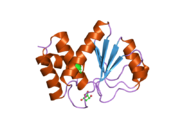- DUSP23
-
Dual specificity phosphatase 23 
PDB rendering based on 2img.Available structures PDB 2img Identifiers Symbols DUSP23; DUSP25; FLJ20442; LDP-3; MOSP; RP11-190A12.1; VHZ External IDs MGI: 1915690 HomoloGene: 32368 GeneCards: DUSP23 Gene EC number 3.1.3.16 Gene Ontology Molecular function • protein tyrosine phosphatase activity
• protein tyrosine/serine/threonine phosphatase activity
• hydrolase activityCellular component • nucleus
• cytoplasm
• cytosolBiological process • protein amino acid dephosphorylation
• dephosphorylationSources: Amigo / QuickGO Orthologs Species Human Mouse Entrez 54935 68440 Ensembl ENSG00000158716 ENSMUSG00000026544 UniProt Q9BVJ7 Q6NT99 RefSeq (mRNA) NM_017823 NM_026725.2 RefSeq (protein) NP_060293 NP_081001.1 Location (UCSC) Chr 1:
159.75 – 159.75 MbChr 1:
174.56 – 174.56 MbPubMed search [1] [2] Dual specificity protein phosphatase 23, also known as low molecular mass dual specificity phosphatase 3 (LDP-3), is an enzyme (EC 3.1.3.16 and EC 3.1.3.48) that in humans is encoded by the DUSP23 gene.[1][2]
References
- ^ "Entrez Gene: dual specificity phosphatase 23". http://www.ncbi.nlm.nih.gov/sites/entrez?Db=gene&Cmd=ShowDetailView&TermToSearch=54935.
- ^ Wu Q, Li Y, Gu S, Li N, Zheng D, Li D, Zheng Z, Ji C, Xie Y, Mao Y (August 2004). "Molecular cloning and characterization of a novel dual-specificity phosphatase 23 gene from human fetal brain". Int. J. Biochem. Cell Biol. 36 (8): 1542–53. doi:10.1016/j.biocel.2003.12.014. PMID 15147733.
Further reading
- Talmud PJ, Drenos F, Shah S, et al. (2009). "Gene-centric association signals for lipids and apolipoproteins identified via the HumanCVD BeadChip.". Am. J. Hum. Genet. 85 (5): 628–42. doi:10.1016/j.ajhg.2009.10.014. PMC 2775832. PMID 19913121. http://www.pubmedcentral.nih.gov/articlerender.fcgi?tool=pmcentrez&artid=2775832.
- Stelzl U, Worm U, Lalowski M, et al. (2005). "A human protein-protein interaction network: a resource for annotating the proteome.". Cell 122 (6): 957–68. doi:10.1016/j.cell.2005.08.029. PMID 16169070.
- Liu CY, Wu MC, Chen F, et al. (2010). "A Large-scale genetic association study of esophageal adenocarcinoma risk.". Carcinogenesis 31 (7): 1259–63. doi:10.1093/carcin/bgq092. PMC 2893800. PMID 20453000. http://www.pubmedcentral.nih.gov/articlerender.fcgi?tool=pmcentrez&artid=2893800.
- Alonso A, Burkhalter S, Sasin J, et al. (2004). "The minimal essential core of a cysteine-based protein-tyrosine phosphatase revealed by a novel 16-kDa VH1-like phosphatase, VHZ.". J. Biol. Chem. 279 (34): 35768–74. doi:10.1074/jbc.M403412200. PMID 15201283.
- Takagaki K, Satoh T, Tanuma N, et al. (2004). "Characterization of a novel low-molecular-mass dual-specificity phosphatase-3 (LDP-3) that enhances activation of JNK and p38.". Biochem. J. 383 (Pt. 3): 447–55. doi:10.1042/BJ20040498. PMID 15281913.
- Bailey SD, Xie C, Do R, et al. (2010). "Variation at the NFATC2 locus increases the risk of thiazolidinedione-induced edema in the Diabetes REduction Assessment with ramipril and rosiglitazone Medication (DREAM) study.". Diabetes Care 33 (10): 2250–3. doi:10.2337/dc10-0452. PMC 2945168. PMID 20628086. http://www.pubmedcentral.nih.gov/articlerender.fcgi?tool=pmcentrez&artid=2945168.
- Tang JP, Tan CP, Li J, et al. (2010). "VHZ is a novel centrosomal phosphatase associated with cell growth and human primary cancers.". Mol. Cancer 9: 128. doi:10.1186/1476-4598-9-128. PMID 20509867.
PDB gallery Categories:- Human proteins
- EC 3.1.3
Wikimedia Foundation. 2010.

